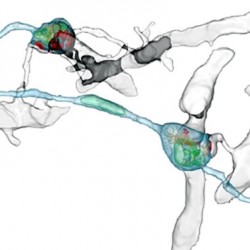By Helen Figueira
May 3, 2013
Time to read: 3 minutes
 Cognitive decline with ageing associated with increased synaptic change
Cognitive decline with ageing associated with increased synaptic change
Conventional wisdom tells us that our brains slow down as we get older. Like a sluggish internet connection forcing its way down out-dated wires, thoughts and memories seem to be struggling along old, inflexible neurons. But what if this cognitive decline isn’t the product of a rigid, slow brain, but an over-active one? New research from the CSC suggests that cognitive impairment during ageing might be the result of an increase in synaptic turnover, rather than a decrease.
The discovery, published in the journal PNAS, came from using a new technique to directly watch neurons as they change in the ageing brain. “Everything we know about how neural circuits age comes from either reduced preparations [neurons in a dish] or fixed preparations [post-mortem studies],” says Vincenzo de Paola (Neuroplasticity and Disease), who led the study. “It would be better if we could label specific neurons and follow them over time in a living ageing brain.” To achieve this, de Paola and his team implanted a small window over the sensory cortex area of old and young mouse brains, and periodically recorded the cell connections while monitoring their cognitive performance.
“Over time we can build up a picture of how these neurons are developing in the ageing brain. To what extent are the rates of change different in an old compared to a young brain?” he asked. Previous literature suggested that in an elderly brain you would find fewer synapses – connections between brain cells – and that these synapses would be inflexible, rarely changing, because a decrease in synaptic plasticity was thought to underlie defects in cognitive skills with age.
“What we found was surprising. These neuronal connections are present at comparable density in old and young animals.” Grappling with this unexpected finding, the team turned investigations to the rate of neuronal turnover. In young, healthy brains, synapses are frequently added and eliminated as we learn new things and recall memories. Could our mental deceleration be due to a decline in this synapse refresh rate?
“Instead of finding less change as we expected, we found more,” reveals de Paola. “Synapses on some nerve cells are added and eliminated at higher rates in the ageing brain. They are more unstable.”
Learning is generally associated with changes at synapses, and it is thought that long-term memories are encoded by strong synapse connections. Another finding of the research was that the increased synaptic instability particularly affects large, strong synapses. “Cognitive impairment could be arising because the strong synapses are becoming unstable,” De Paola explains. “This could increase the noise in the processing of information. In healthy adult brains most synapses are stable over several weeks and months.”
Without this consistency, ideas and thoughts dangle just out of reach. New synapses do continue to form in old age, but the connections they make are weak and unreliable. The next step in the research is to confirm that this increased turnover is causing the cognitive change. Although the prospect of reversing the changes is some way off, understanding the fine-tuning of synaptic balance could have major clinical implications.
Reference: Grillo, F. W., Song, S., Teles-Grilo Ruivo, L. M., Huang, L., Gao, G., Knott, G. W., Maco, B., Ferretti, V., Thompson, D., Little, G. E., De Paola, V., (2013). Increased axonal bouton dynamics in the aging mouse cortex. Proceedings of the National Academy of Sciences 110 (16), E1514-E1523.
And for more information see this Nature Highlight.
AL